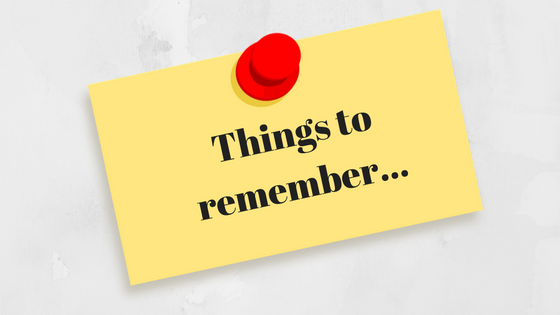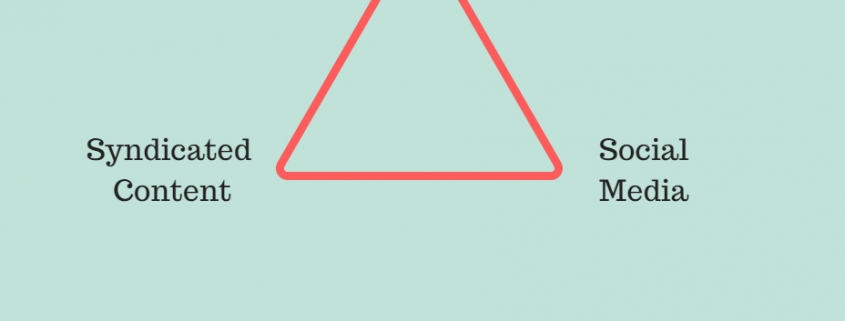It’s late Saturday morning. You are new in town and are ready to go explore.
You step out your front door, a little uncertain in which direction you should go, when you notice the neighbors on either side of you are also out in their front yards.
One family is playing with their kids on the swingset, and the other is preparing a barbecue. They both come over to ask what you are up to today.
“I’d like to find a really good coffee shop nearby.”
“You should definitely check out the shop at the corner of Vine and Maple called Coffee Dreams. It’s great!”
“Yes,” replies the other neighbor. “That’s my favorite coffee shop! Make sure you try their pumpkin spiced latte. You’ve never tasted anything quite like it.”
You thank them for their friendly recommendations, hop in your car, and after a short drive, find a place to park, and walk in.
There is a funky blackboard behind the counter with colorful names of coffee varieties, some sandwich selections, and delicious-sounding pastries. The chairs and tables are each unique, and comfortable for small group conversation.
You like the way it feels here. You start to chat with the barista, who is really friendly and helpful. The shop owner introduces herself and offers some great information about the unusual coffee flavors she offers.
Being a real coffee aficionado, you inquire about the origin of the beans and the different ways of preparing coffee, and the owner enthusiastically engages you in conversation. She also encourages you to join her newsletter list, so you can get more information in the future.
You finally leave about 90 minutes later, telling yourself that you’ll definitely be back. This is a good place to hang out.
Same story – Online
Now imagine this same scenario, but instead of in your neighborhood, it’s online. You are interested in a particular topic, like coffee.
You notice that your social media friends have been talking about a specific coffee shop, so you check the reviews online, and discover that the place has raving fans.
When you do a search for coffee shops in your town, it shows up on page 1 of the results, so it’s easy to click on the link to get to the website.
When you get to the webpage, you discover that they not only list their menu items and hours, but they also have a blog with really fascinating information.
After reading for a while, you get to the bottom of the third blog article and notice that you can sign up for their monthly newsletter to keep up to date with all the latest happenings at the shop.
By this time you are hooked, so you are happy to give up your email address.
Then you head out the door to try it out for real!
The 3S Marketing System
In this situation, just like in the real life situation, you have a vital intersection of content marketing, keywords (SEO), and social recommendations (social media).
In fact, the synergy between these three is critical for both the consumer and the proprietor. This is why I call it the 3S Marketing System: SEO, Syndicated content, and Social media.
The consumer (prospect) needs the content in order to become more knowledgeable about the topic, and can only find their way there through a combination of recommendations and keyword searching. The content also helps the consumer feel comfortable with the proprietor, desiring to come back in the future.
The proprietor first needs to decide which keywords will be most obvious for the service offered, and which will likely be most effective at drawing in their perfect customer (avatar). Then she needs to create great free content that speaks directly to that prospect, and his interests.
When the prospect visits, he has a great experience, and it isn’t long before he, too, is telling all the neighbors about how much he loves Coffee Dreams!
Is it relevant?
It goes without saying, of course, that people who don’t like coffee won’t be attracted to a place like Coffee Dreams, either online or in real life. And that is perfect.
The owner of Coffee Dreams wants lots of coffee lovers to show up! But she doesn’t have time for people who aren’t interested in coffee. So she provides content on her site and in her store that is relevant only to coffee lovers.
What do these scenarios really mean for you and your business?
It means you have to leverage the power of combined SEO, content marketing, and social media to build your business.
The first first key to this formula is to fully understand relevance.
As anyone who has tried to work with SEO (Search Engine Optimization) knows, search engines are constantly evolving.
And although it may feel as if that evolution is intended to harm marketers and make their lives difficult, the truth of the matter is that it is intended to provide the user with a satisfying experience.
So don’t take it personally. It’s not about you; it’s about your prospect. As it should be for you too.
Instead of being upset about the constant rotation of Google’s “zoo” (Penguin, Panda, etc.), if you keep in mind the PURPOSE of your marketing, you will be just fine, no matter what the search engines do.
That purpose? To create a relationship with your prospect that brings them on a journey. The benefit to YOU, of course, is that during that journey, they go from prospect, to lead, to customer, to raving fan.

What is the intent?
To determine how relevant your content is to your target audience, you really need to know the intent behind their search.
While you, as the content person (yes, you!) may be interested in choosing the right keywords for your meta description and to sprinkle throughout your text, your target audience simply wants an answer to a question.
First, we need a couple of definitions, because people often tend to mix these up:
Keyword: A term used to describe something (for the marketer)
Query: What a user types into a search engine to accomplish something or to get an answer (for the searcher)
So ask yourself these questions as you search for keywords:
If my audience member is typing in a query, what is their goal?
Are they looking for information?
Are they comparing different versions of the same thing?
Are they looking to buy something right now?
What keyword(s) can I choose that will be the end result of their query?
1 – Enter the funnel through SEO
Since most traffic comes from people who are looking for information, leverage that search to drop them into your marketing funnel.
Where do they end up? On your website! Reading your blog, watching your video, etc.
Ideally, you will have custom content, specific both to you/your company and to your audience.
Although some businesses use generic content (and this may be just fine for businesses like doctors and attorneys and chimney sweeps, that are built entirely on local traffic), in general, you want to use custom content.
Custom content – that is, content provided by you and your team, specifically for your audience – helps preserve your “voice” and attracts exactly the right type of person to your business.
Besides, you know your audience best, and you know your solution to their problem best. So you are the best person (or someone on your team who knows how to articulate your voice is best) to share how your solution solves your prospect’s problem.
So don’t skimp on this critical part of the 3S System. Custom content, produced on a regular basis (it’s important to the search engine spiders that you produce new content frequently), and distributed widely over a variety of platforms (syndicated) is a key element in the SEO algorithm.
Ad – Want help with your content? Join Content Marketing Pro!
2 – Great content – syndicated
Of course, in addition to your content being custom-made for your audience, your content needs to be EXCELLENT to keep them there, and to get them to continue to engage with you.
And as we already stated, great content starts with its relevance to your audience. So you really, really need to know your avatar.
Once your audience knows that you exist, great content that meets their needs helps them begin to like you.
If they like you, they will keep coming back for more great content. Now they trust you!
Think about it: Do you trust someone you don’t know? Or someone you don’t like? Of course not!
Remember that trust means “absence of doubt”. Your prospect has to have no doubt that your intentions are to help them. If they think there is any chance of you not fulfilling your promises, that’s it; “gave over”.
So focus on this: RELATIONSHIP COMES BEFORE ROI.
Build that relationship with excellent custom content.
Brand recognition
So here is the process so far:
SEO brings traffic to your site → great content builds trust
SEO is the technical stuff. Content is all about building trust through relationships. You want to create brand recognition.
There is a LOT to creating brand recognition. For today, here are a couple of quick tips:
- Know your avatar so well that you choose colors and symbols for your logo and other visuals that really resonate with them
- Provide great value. Over and over and over. Exceed expectations.
- Tell great stories about you and your company.
- Tell great stories that highlight your customers.
- Be everywhere. Syndicate your content so you are top of mind when your audience thinks of your topic.
- Be all over the social media channels frequented most by your avatar. Again, become familiar through repetition.
3 – Social Media
And this leads us to the final corner of the 3S Marketing System triangle: social media.
96% of all web activity is now on social media. The search engines have recognized this, and now include many platforms in search results.
In fact, if you are not prolific on social media, you are probably not relevant. And remember what we said about how important relevance is!
Now we are ready for the final step in the process:
SEO brings traffic to your site → great content gets conversions to your list → social media presence
No matter how relevant your content is to your prospect’s search, and no matter how great the content is, the easiest way to convert your lead to a customer is through their friends’ recommendations.
This is why social media MUST be part of your marketing strategy.
Social media must be both engaging and inspiring: get your audience to think, to relate, to consider, to comment, to share.
When they share your content – short posts, images, videos, links to longer posts – they both feel like they are participating, and they are recommending you to their friends and followers.
Don’t you trust your neighbor’s recommendation for an auto mechanic more than you trust the mechanic’s marketing claims?
When you show up on social media, you are able to reach a whole new web of prospects, thanks to one person sharing to their friends, than one of them sharing to their friends, etc.
Social media is how you increase visibility and credibility. And, to bring it all full circle, the more people share your content, the more the search engines trust you.
So in the same way that you trusted your neighbors to find a coffee shop that is perfect for you, and once you were there, you fell in love with it, your prospects actually WANT to fall in love with a solution to their problem. They want to find you!
So through the power of the 3S Marketing System, make it as easy as possible for your perfect audience to find your perfect solution.
Great, relevant content, found through targeted SEO and a prolific social media presence.
Take care of these three corners of the triangle, and you have a solid presence online, that will help your business grow.
- People trust their social friend’s recommendation more than a Marketer’s
- Social media must be part of your marketing strategy
- Get social media to do your marketing for you.
- Create a graphic here
- When on social media, you are able to reach a whole new web of prospects, based on one person who follows you. Friends, family, colleagues
- Increase visibility and authenticity so both customers and search engines trust you
You need to have a relationship before you can count on ROI.
If you liked this post, join our 30 Days To a Flood of New Leads program! You will learn ALL you need to know to create engaging, valuable content, that inspires your prospects to take action!





